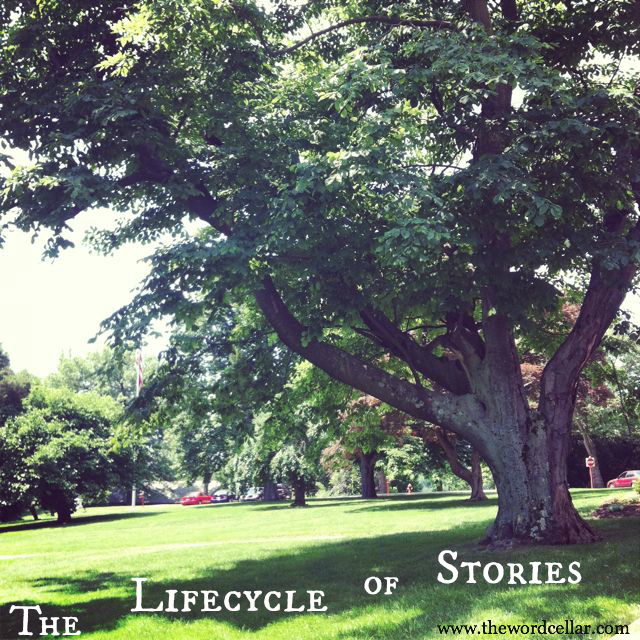The Lifecycle of Stories
 Monday, April 29, 2013 at 6:29PM
Monday, April 29, 2013 at 6:29PM 
Some stories are like grasshoppers: Fully formed and jumping from day one. (A little bit of time and revision is all they need to earn their wings.)
Some stories are like butterflies and moths: The first draft doesn't look much like the end result, but the metamorphosis from a small caterpillar of an idea to the bright final product doesn't take all that long.
And some stories are like cicadas: Hatched above ground on a slim branch, fed by sap, they then drop to the ground to burrow beneath. They live in this quiet, subterranean way for a long time -- one year, two years, sometimes seventeen years -- feeding on the roots of the tree where they were born, and waiting. And then one day, they emerge as nymphs from their underground hiding place, take again to the trees, and transform once more into something winged and wondrous.
(Pretend for a moment that cicadas don't give you the creeps.)
Like cicadas, some stories need a long time away from the light before they're ready to come out of hiding and sing their song.
Don't like insects? Forget the metamorphosis metaphor and choose your own. Stories need time to: hibernate, gestate, mature, ripen, age, mellow, ferment, distill.
Take, for example, The Saddest Dog Story in the World.
The real-life events of this story occurred in the mid-1980s. It entered my repertoire of anecdotes some time during the following 10 years. Within another 10 years the anecdote even had a title: The Saddest Dog Story in the World. I actually mentioned it in my very first blog post back in October 2004, promising to tell it at a later date.
I've been trying, sporadically, to write this story ever since. A few years ago I tried valiantly to shape it into a story to tell at The Moth StorySLAM, but I couldn't make it work. It refused to transform from anecdote to story.
The Saddest Dog Story in the World was a good anecdote, the kind that is so sad it's almost funny. But an anecdote that works at dinner parties doesn't automatically translate into a story that works on the page or the stage. To craft life into art, which is what we're doing when we create stories from our lives, we need more than anecdote.
We need meaning.
Anecdotes are a series of events: one thing happens, then another, and another. Stories, though, go deeper. They combine anecdote with reflection to unearth and convey the meaning of the events at hand. {Ira Glass, host of the radio show "This American Life," explains these story building blocks in this video. Author Sue William Silverman calls these two building blocks the "voice of innocence" (anecdote) and the "voice of experience" (reflection) and applies them to writing creative nonfiction in this essay and in this book.}
It seemed that no matter what I did, I just couldn't get to the heart of The Saddest Dog Story in the World. So for years, it remained something more akin to The Sad But Funny Anecdote About the Only Dog I Ever Had.
During those years, I'd also been trying to craft a stage-worthy story -- any story, not just the sad dog story. But something about the live storytelling genre eluded me. I'd wrongly assumed that creating stories for the stage would be an easy jump from writing them for the page. But every time I tried to make that leap, the distance between the two felt like a dark, yawning cavern -- mind boggling and impossible to cross.
And then three months ago I went to New York City and gave a short talk about something completely unrelated to the dog story or any of the others I'd been trying to tell. The presentation ended up being like the love child of a Moth story and a TED talk, but it seemed to flip a switch in my creative brain.
The very next day, while brushing my teeth in the closet-sized bathroom of my Soho hotel room, the Saddest Dog Story in the World crawled out of its underground hiding place, sprouted wings, and started to buzz.
The anecdote I'd lived with for 15 years coalesced, formed itself into a story, and showed me its heart. I still had to shape and refine it, but I finally understood what the story meant, which finally made it more than just a sad-funny story to tell over drinks.
Some stories are like this. You carry them around for days, weeks, months, years -- decades even. You write the beginnings of them dozens of times. You know pieces of them inside and out, and yet something essential to them remains hazy, elusive.
This isn't just about trying to work in a new genre (live storytelling versus written essay, for example). This is about the lifecycle of stories -- of any kind of art, really.
I think that sometimes stories (or paintings, films, songs, etc.) come to us before we know how to bring them to life. They come in snippets, half-hidden, in a scatter of details.
Without faith in the idea, you might not trust that there's anything there at all.
Without faith in yourself, you might not have the courage to keep trying.
But just because you don't see something doesn't mean it isn't there.
Just listen through your open window on a warm summer night.
** ** **
I know. Now you want to know The Saddest Dog Story in the World.
Soon.
I promise.


Reader Comments (1)